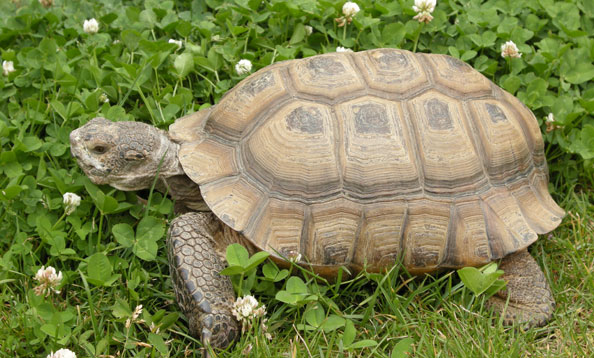Mojave Desert Tortoise
Gopherus agassizi

Fascinating Facts
- The desert tortoise is California’s state reptile, and practices lithophagy – swallowing rocks to aid in digestion.
Physical Characteristics
These tortoises weigh from 10 to 20 pounds with a carapace (upper shell) length of up to 15 inches. The shell is high domed with prominent growth lines on shields of both carapace and plastron (lower) sections. The top is brown or horn-colored; bottom is yellowed. The limbs are stocky; and when drawn in completely close the opening of the shell. The head is fairly large in proportion to the body. The tail is short, though longer in males. Foot claws are longer and sharper in adults. The gular (throat) shields are longer on the male, with a scent gland lump on each side of the lower jaw.
Habitat/Diet
Desert tortoises are found in the desert regions in the southwestern United States to northwestern Mexico. They are excellent burrowers and hibernate in communal burrows.
In the wild, these herbivores eat wild grass, flowers, cactus pads and fruit. At the Zoo, they are fed a variety of leafy greens and fruits and vegetables, as well as alfalfa hay.
Social Behavior
Desert tortoises engage in an elaborate courtship. The males have head bobbing and ramming matches. Males can have harems of 10 to 60 females. Females are able to store sperm for up to four years. In June, females lay 6 to 13 elongated eggs in a ground hole. After incubating for 3 to 4 months, two-inch hatchlings hatch out. Parents exhibit no parental care.
Status In The Wild
Desert tortoises are threatened. In the wild, many tortoises empty their storage and anal bladder when threatened or picked up and dehydrate before reaching the next watering hole. Habitat destruction, pet trade, automobiles, and respiratory disease have reduced their numbers greatly. The respiratory disease was introduced into wild populations when people released infected desert tortoises they had as pets in an attempt to help re-establish the population. Unfortunately, it did more damage than good.
Other
Our desert tortoises are part of the collection of educational outreach animals that are housed at the Koret Animal Resource Center (ARC). The tortoises are brought to classrooms as part of the ZooMobile program, and can be seen by the public on the Nature Trail in the Children’s Zoo between Memorial Day and Labor Day.
